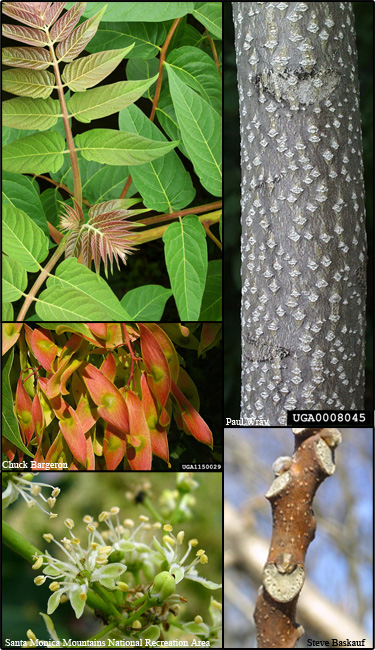Tree of Heaven (Ailanthus altissima)
 Common Names: Ailanthus, Copal tree, Stinking sumac, Varnish tree, Chinese sumac, Paradise-tree
Common Names: Ailanthus, Copal tree, Stinking sumac, Varnish tree, Chinese sumac, Paradise-treeDescription: Extensive cloning; allelopathic properties present. Introduced as an ornamental because it grows quickly and is very attractive. It has a medicinal history in Asia where it has been used as an astringent, antispasmodic and parasiticide. Plant extracts are also used as herbicides. It is also a food for honeybees worldwide.
Habit: Deciduous small to large tree; 12-20 m (40-65 ft) tall and 60-100 cm (24-40 in) in diameter; crown wide-spread with multiple branches.
Leaves: Alternate, pinnately compound with 11-30 lance-shaped leaflets, leaves 30-90 cm (1-3 ft) long, 1-5 small gland tipped teeth near the base of each leaflet, dark green above and pale green below, turn yellow in fall; smell like rancid peanut butter when crushed.
Stems: Twigs very stout, light to dark brown, smooth with large V-shaped leaf scars; bark thin, gray to brownish gray, smooth with shallow fissures appearing on older trunks.
Flowers: Small, yellow-green in color, 5 petals; borne in dense clusters near ends of upper branches, male and female flowers on different plants, pollen has an offensive odor; blooms in late spring.
Fruit and seeds: Two-winged, papery, flat samara; reddish when ripe; develop in clusters on female trees in fall, persist in winter, germinate readily, dispersed by wind, birds and water.
Habitat: Shade intolerant; thrives in poor soils; found in disturbed soils, fence rows, fields, roadsides, woodland edges, forest openings and rocky areas; very fast growing.
Reproduction: By seed and vegetatively via root suckering, up to 350,000 seeds produced annually by a single plant.
Similar species: Crushed leaves or broken stems of native sumacs (Rhus spp.); walnuts (Juglans spp.) and ash (Fraxinus spp.); lack rancid peanut butter aroma; leaves lack gland-tipped teeth at base.
Monitoring and rapid response: Monitor edges, paths; hand pull seedlings before taproot develops (<3 months) as taproot fragments may resprout. Resprouts following cutting, girdling, mowing, burning - follow-up treatment required; girdling followed by herbicide most effective; treat cut stumps with an herbicide, all stems in a clone must be treated; basal bark treatment with herbicide provides good root kill, particularly in fall; foliar herbicide treatment is effective on small trees. Credits: The Michigan Natural Features Inventory (MNFI) has partnered with MISIN to provide the information in this fact sheet. Species images and/or information were used with permission from "A Field Identification Guide to Invasive Plants in Michigan's Natural Communities" and "A Field Guide to Invasive Plants of Aquatic and Wetland Habitats for Michigan.
STATUS | Priority Species |
Common Name: | Tree of Heaven |
Scientific Name: | Ailanthus altissima |
Family: | Simaroubaceae (Quassia) |
Duration: | Perennial |
Habit: | Trees |
USDA Symbol: | AIAL |
 View Species Course |
|
